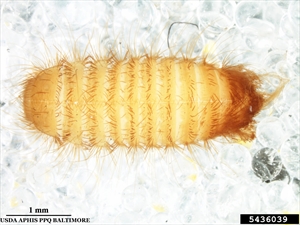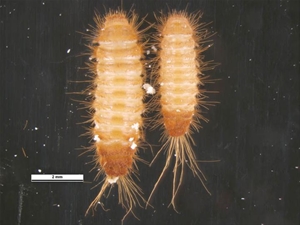Khapra beetle
Pacific Pests, Pathogens, Weeds & Pesticides - Online edition
Pacific Pests, Pathogens, Weeds & Pesticides
Khapra beetle (483)
Trogoderma granarium; previously known as Trogoderma afrum, and Trogoderma khapra.
Africa, Asia, Europe (restricted). It is not present in Australia nor New Zealand, but is regularly intercepted. It is yet to be recorded in Pacific island countries.
Grains (barley, maize, millet, rice, sorghum, wheat); oilseeds (canola, peanuts, soybeans, sunflower); nuts (almonds, pecans, walnuts); pulses (broad beans, chickpeas, field peas, lentils, mung beans). It is also found in processed products, such as flour, noodles, dried coconut, dried milk, fish meal, and even animal skins, fodder, sacks and wool.
Larvae do the damage, feeding on products that have as little as 2% moisture. Females lay 50-100 egg, which hatch into reddish-brown larvae, becoming golden-brown with age, up to 7 mm long, 1.5 wide, with long hairs over their bodies, particularly at the hind end, like a brush (Photos 1&2). Pupation lasts 2-5 days.
Adults, 2-3.5 mm long - females slightly larger than males - oval, reddish-brown, and with fine hairs on the back (Photos 3-5). Adults rarely feed; neither do they fly. They are short-lived: males 4-12 days; mated females 4-7 days; and unmated males 20-30 days. Females begin egg-laying shortly after mating.
Khapra beetle occurs mostly in regions with hot, dry climates. It can go into a state of suspended development (called diapause) if temperatures are low, food is poor or populations too high; diapause can last up to 9 months.
Spread occurs in infested grains, seeds, and processed products, such as oilcakes and brans traded on domestic and international markets, as well as on or in second-hand bags, ships, and containers used to transport them.
Khapra beetle can cause weight losses of 5-30% and occasionally up to 70% from direct feeding. Germination of seed can be affected. Infested grain also becomes contaminated with cast skins and hairs from larvae, which can be a health risk (intestinal problems and asthmatic reactions) and are also difficult (and costly) to remove from consignments, grain storage buildings and transport vessels. The impact on trade for those countries not yet infested by khapra beetle is potentially very high. In Australia, it was estimated in 2005 that if introduced the beetle would cost the agriculture sector between $A50 and $A120 million a year.
Look for the hairy larvae but, more especially, look for cast skins or hairs - often they are the first sign of an infestation. Look into cracks, crevices, behind panelling and under shelves in warehouses, and under the flooring of containers. Look just before dusk when larvae are most active. However, because larvae and adults are similar to related species (e.g., warehouse beetle, Trogoderma variabile) identification of this critical quarantine pest is best done by a specialist as it often requires dissection of the mouth parts or reproductive organs. Monitor facilities using pheromone and larval traps.
See OEPP/EPPO Bulletin (2013) 43(3): 431-448 PM 7/13 (2) for a detailed diagnostic protocol for Trogoderma gransarium: (https://onlinelibrary.wiley.com/doi/full/10.1111/epp.12080). The EPPO Data sheet on Trogoderma granarium also provides information on the biology of the insect: (https://gd.eppo.int/taxon/TROGGA/documents).
BIOSECURITY
Many countries have specific quarantine regulations against possible importation of Trogoderma granarium. Those without regulations and especially those not yet infested should consider all likely pathways for entry, and apply quarantine measures accordingly. Particular attention should be given to the fact that khapra beetle feeds on many types of stored products, breeds rapidly, and that it can go into a state of arrested development (diapause) in response to poor food, high populations or low temperature, making it difficult to control.
A draft National Khapra Beetle Action Plan 2020-2030 has been produced for the Australian Government to manage the threat of it entering and establishing in Australia: (https://haveyoursay.awe.gov.au/khapra-beetle-action-plan).
Trogoderma granarium is on the Global Invasive Species Database (2020) of information on alien and invasive species that negatively impact biodiversity, managed by the Invasive Species Specialist Group of the IUCN Species Survival Commission: (http://www.iucngisd.org/gisd/speciesname/Trogoderma+granarium).
CULTURAL CONTROL
Hygiene measures are particularly important to keep this pest under control in countries where it is present.
Before storage:
- Practice good hygiene. Remove all infested grains, oilseeds, pulses or their products from warehouses and stores before replacing with fresh consignments.
- Sweep floors, clean walls, doors and vents to collect seeds, grain powder and dust, and burn them before storing the new harvest.
- If using bins, remove any remains from the last harvest. If using sacks, do not reuse those that stored previous commodities.
- Collect and dispose of spilled consignments around storage areas.
- Fill any cracks and crevices where khapra beetles can hide.
During storage:
- If there is an infestation, it will need to be treated by fumigation (see below).
- Use pheromone traps to monitor khapra beetle presence in storage facilities.
- Be aware of khapra beetle appearance and biology; carry out checks of storage facilities (especially of commodities that are often hosts), and any imported vehicles or cargo; report any unusual signs of damage or pests (in particular unusual insect skins or hairs) to agricultural authorities immediately.
CHEMICAL CONTROL
- Fumigation with methyl bromide is still allowed for the control of Trogoderma granarium under the Montreal Protocol; however, this ozone-depleting chemical is being deregistered in most countries. (The European Union no longer allows methyl bromide for the control of quarantine pests.)
- Phosphine is used to manage infestations, preferably for 7 days. Note that below 25oC hibernating larvae are less susceptible to the fumigant. Fumigation does not prevent re-infestation so monitoring of stocks plus hygiene in warehouses generally is important. See the OEPP/EPPO Bulletin (2012) 43(3) for a standard on phosphine fumigation to control Trogoderma granarium: (https://onlinelibrary.wiley.com/doi/pdf/10.1111/epp.2597).
- In Australia, a minor use permit has been issued for the use of sulfuryl fluoride to control Trogoderma granarium in commodity storage structures for cereal grains, baled hay and seed storage facilities from 2018 to 2025.
- Heat treatment is effective if given at 60oC for 30 minutes or at 42.5oC for 8 days.
- Malathion is approved in Australia for control of khapra beetle infestations in and around structures and surrounding areas.
____________________
When using a pesticide, always wear protective clothing and follow the instructions on the product label, such as dosage, timing of application, and pre-harvest interval. Recommendations will vary with the crop and system of cultivation. Expert advice on the most appropriate pesticides to use should always be sought from local agricultural authorities.
AUTHOR Grahame Jackson
Information from CABI (2019) Trogoderma granarium (khapra beetle) Crop Protection Compendium. (https://www.cabi.org/cpc/datasheet/55010); and Andras Szito (2020) Khapra beetle - declared pest. Department of Primary Industries and Regional Development (entomology). Government of Western Australia. (https://www.agric.wa.gov.au/biosecurity/khapra-beetle-declared-pest?nopaging=1); and from Akol AM, et al. (Undated) Trogoderma granarium Everts, 1899 - Khapra beetle. BioNET-EAFRINET Keys and Fact Sheets.(https://keys.lucidcentral.org/keys/v3/eafrinet/maize_pests/key/maize_pests/Media/Html/Trogoderma_granarium_Everts_1899_-_Khapra_Beetle.htm#Contact). Photo 1 James D. Young, USDA APHIS PPQ, Bugwood.org. Photos 2-5 Simon Hinkley & Ken Walker (2005) Khapra beetle (Trogoderma granarium): PaDIL - (http://www.padil.gov.au).
Produced with support from the Australian Centre for International Agricultural Research under project HORT/2016/185: Responding to emerging pest and disease threats to horticulture in the Pacific islands, implemented by the University of Queensland and the Secretariat of the Pacific Community.









